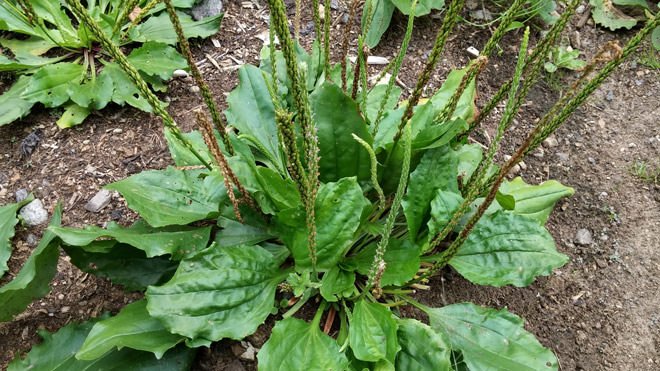Found nearly everywhere, this plant is fully edible and can be used as an antivenom, soothing itches, and as a topical treatment for hemorrhoids. The leaves are harvested during the flowering period to make infusions with.

Photo by @krnel
Key Points
- grows everywhere
- fully edible
- good for survival situations as food and medicine
- safest plant to eat that I've covered so far in Getting to Know Herbs
History
The common plantain goes by the scientific term Plantago major, also known as the Broadleaf Plantain, White Man's Foot, Erva-De-Orelha, General Plantain, Grand Plantain, Greater Plantain, Llantén, Plantago asiatica, Plantago major, Plantago Mayor, Plantain, Plantain à Bouquet, Plantain Commun, Plantain à Feuilles Larges, Plantain Majeur, Plantain des Oiseaux, Tanchagem.
The common plantain is believed to be a pioneer plant from Europe to North America during colonization. The reference to "white man's foot" was given by the Native Amerindians because it emerged in the disturbed and damaged areas of European settlements.
Where is it found?
It's native to most of Europe and north and central Asia, but it's been introduced into many more areas of the world, such as North America where it can be found everywhere in lawns, on the roadside, and in gardens to name a few places. It does well in compacted and disturbed soils.
What's it used for?
The ability to survive being frequently trampled on makes it an ideal plant to rehabilitate soil, as the roots help to break up hardened surfaces, while at the same time holding the soil together to prevent erosion.
The entire plant is edible. Young leaves are more tender to be eaten in salads, but quickly become fibrous and tough. Some people boil them for eating in salads, soups or stews. Seeds can be eaten raw or cooked, and ground into a meal to be mixed with flour. Dried leaves are used to make herbal tea. The leaves have calcium, phosphorus, potassium, magnesium and more minerals, as well as vitamin A, C, K, B6 and B9 in substantial amounts.
The common plantain has substances that can decrease pain, inflammation, mucus production, open airways and kill bacteria and fungi. It can treat bladder infections, bronchitis, colds, irritated or bleeding hemorrhoids and skin conditions or eye irritations.
The root is said to be useful as an anti-venom to treat rattlesnake bites.
Are there any risks?
It's pretty safe all around for most adults taken orally. It might cause diarrhea and low blood pressure.
Pregnant women should avoid it as it might affect the uterus and increase the change of a miscarriage. Avoiding when breast feeding is recommended as well since it's not known whether it is an issue, but it might be fine. Those with melon allergies might also be allergic to the common plantain.
Those taking Warfarin (Coumadin) to slow blood clotting should avoid the common plantain as it might decrease the drug's effectiveness since it helps blood clotting.
References:
Previous posts on Getting to Know Herbs:
Eleuthero (Siberian ginseng) | Black Cohosh | Common Bearberry | Mahonia Mountain Grape (Oregon Grape) | Blue Cohosh | Goldenseal
Thank you for your time and attention. Peace.
If you appreciate and value the content, please consider: Upvoting, Sharing or Reblogging below.
 me for more content to come!
me for more content to come!
My goal is to share knowledge, truth and moral understanding in order to help change the world for the better. If you appreciate and value what I do, please consider supporting me as a Steem Witness by voting for me at the bottom of the Witness page.


